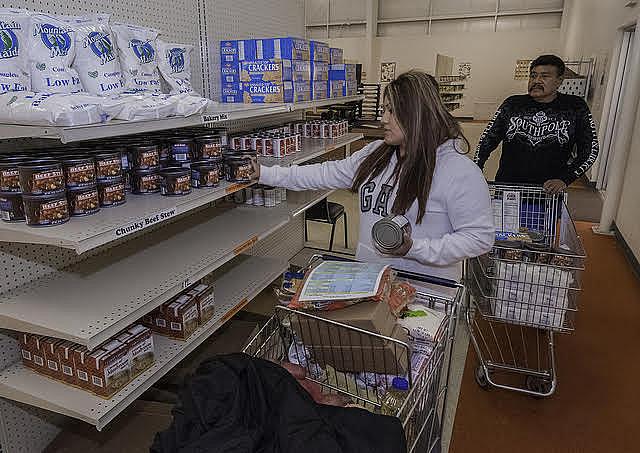Not exactly ‘Blue Apron,’ Trump plan stirs unhappy memories of commodity reservation foods

Kristen Watts and her father Joe Nerva shop for food at the distribution warehouse of the Five Sandoval Indian Pueblos in Bernalillo, New Mexico, part of USDA’s Food Distribution Program (FDPIR) on Indian Reservations.
TULSA, Okla. — Apollonia Piña still remembers the taste, smell and texture of the commodity beef she had as a child.
“After you scraped away the layer of congealed fat on the top of the can, you’d get this brownish stuff that looked and smelled like cheap dog food,” the Muscogee (Creek) Nation citizen said.
Growing up in rural Oklahoma in the 1980s and early 1990s, Piña’s family participated in the U.S. Department of Agriculture’s Food Distribution Program on Indian Reservations (FDPIR), an alternative to SNAP (food stamps) offered to rural Native families.
In order to participate in the program, eligible households must meet similar income requirements as SNAP participants, live either on or near a reservation or in certain areas of Oklahoma and not have a nearby licensed SNAP vendor, such as a grocery store or farmers’ market. Nationally, about 90,000 people participated in the program in 2017, with more than one-third based in Oklahoma.
Federal legislation now places an additional emphasis on providing fresh or frozen food and more tribes have set up grocery store-style facilities in recent years to allow participants to select what commodities they want. However, that experience is a comparatively recent development and is not universal, as many participants still only receive processed foods through the program.
As part of his 2019 budget proposal, President Donald Trump recommended replacing a portion of the monthly SNAP benefits with a box of canned and shelf-stable grocery items. Although federal officials billed the change as on par with Blue Apron, Hello Fresh or other mail-order meal services, the announcement, coupled with the revelation that the “America’s Harvest Box” would not include fresh produce like the aforementioned subscription meal services, promptly drew comparisons to FDIPR rations from Piña and others familiar with the commodity food program.
“People keep comparing it to Blue Apron and that tells me that they really don’t know what it’s like,” said Piña, the Muscogee (Creek) Nation citizen.
“It’s not anything like the Blue Apron program. That’s fresh fruits and vegetables — the commodity program is anything but.”
Many studies have shown the deleterious health effects that stem from an over-reliance on processed food, including elevated risks of heart disease and high cholesterol.
According to data published by the Department of Health and Human Services’ Office of Minority Health, American Indians and Alaska Natives are 60 percent more likely to be obese than their non-Native neighbors. Obesity in turn, carries additional health risks, including high blood pressure, high cholesterol and increased rates of stroke and heart disease.
Studies have also shown a correlation between diabetes and an increased intake of corn syrup and other refined carbohydrates, a common ingredient in many low-cost, shelf stable, processed foods.
Virtually unknown in Indian Country until the 1950s, the disease is now more than twice as common among American Indians and Alaska Natives than the general population. Once known as adult onset diabetes, the rate of Type 2 diabetes among Native American youth is now estimated at almost 50 diagnoses a year for every 100,000 teens — more than double that of any other group.
The food often made available through FDPIR does not exactly lend itself to healthy nutritional outcomes.
For example, a two tablespoon serving of commodity creamy peanut butter has higher percentages of total fat and saturated fat than its commercial counterpart, as well as a higher sodium content.
Although it has 80 percent of the recommended daily intake of Vitamin A, a single cup serving of canned commodity beef stew also accounts for almost 40 percent of an adult’s recommended daily sodium intake.
“In general terms, it (commodity foods) is responsible for some of the top causes of death in Indian Country simply because of the nutritional composition — or lack thereof — of your average commodity food box,” Valerie Segrest said.
A citizen of the Washington-based Muckleshoot Tribe, Segrest is a nutritionist and the coordinator of her tribe’s food sovereignty project. As part of its efforts to reintroduce traditional food and beverage sources to the community, customary dishes are served at least one day per week at the six kitchens in the tribe’s program.
Although she has not conducted research to determine whether bringing back nettle tea, huckleberries and seafood soup has lowered the diabetes rate around Auburn, Washington, Segrest is getting positive feedback from all corners of the community.
“The common sense approach of folding traditional foods in … it is helping people feel better and they’re noticing that their body can talk to them,” she said. “That kind of connection is more important to me than say, doing blood draws.”
Meanwhile, Piña and her family are receiving SNAP benefits while she finishes her degree at the University of Oklahoma. She says she’s grateful for being able to choose what foods she feeds her infant son rather than having those decisions made for her.
“Growing up on commodities, it’s very unhealthy,” she said. “The choices are all processed and there are a ton of preservatives. When I purchase organic produce with my SNAP benefits, I get judged for that. People think I’m being fancy pants for it, but I want to make sure that my son is eating better than I did when I was his age.”
[Photo by USDA via Flickr.]

